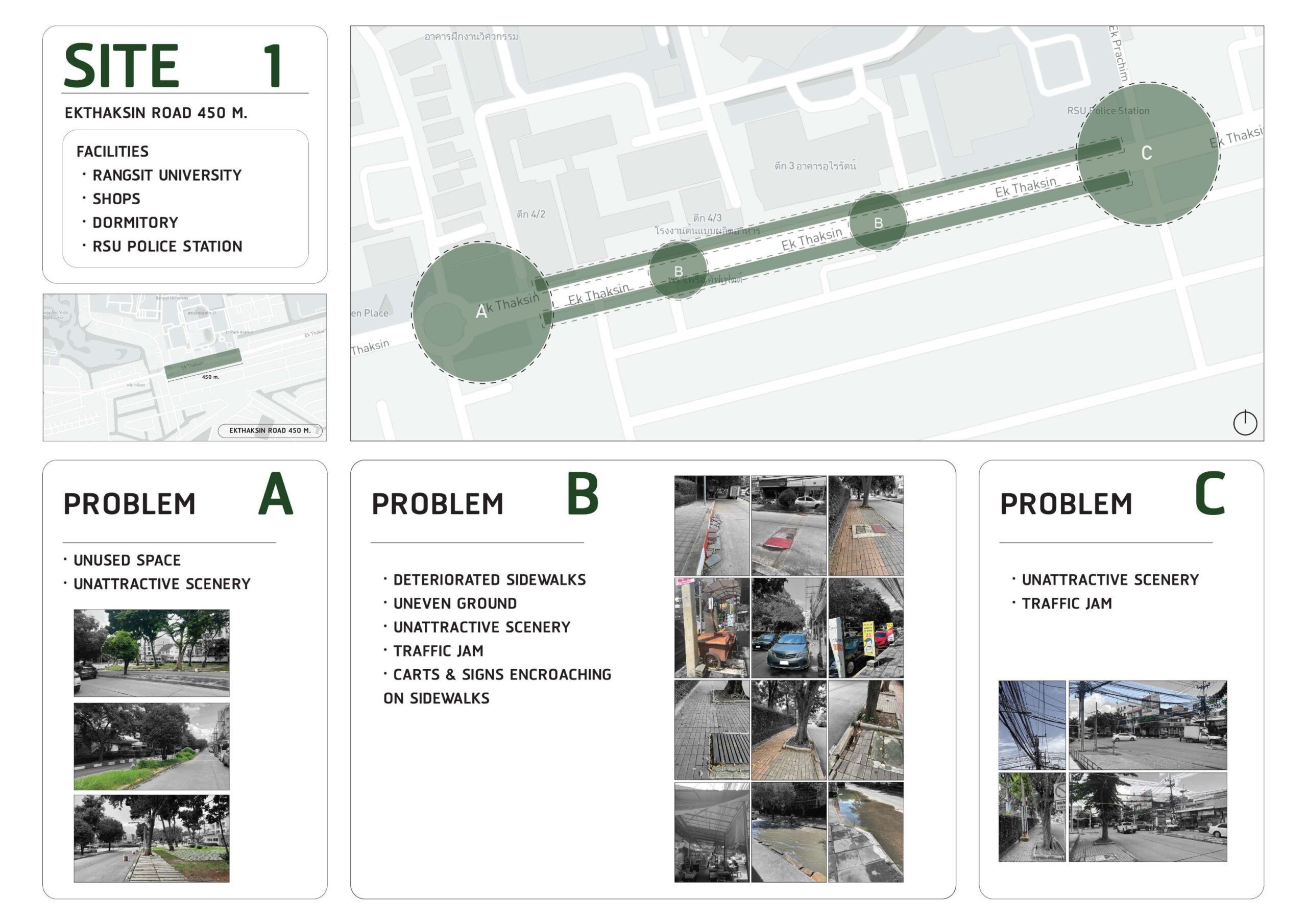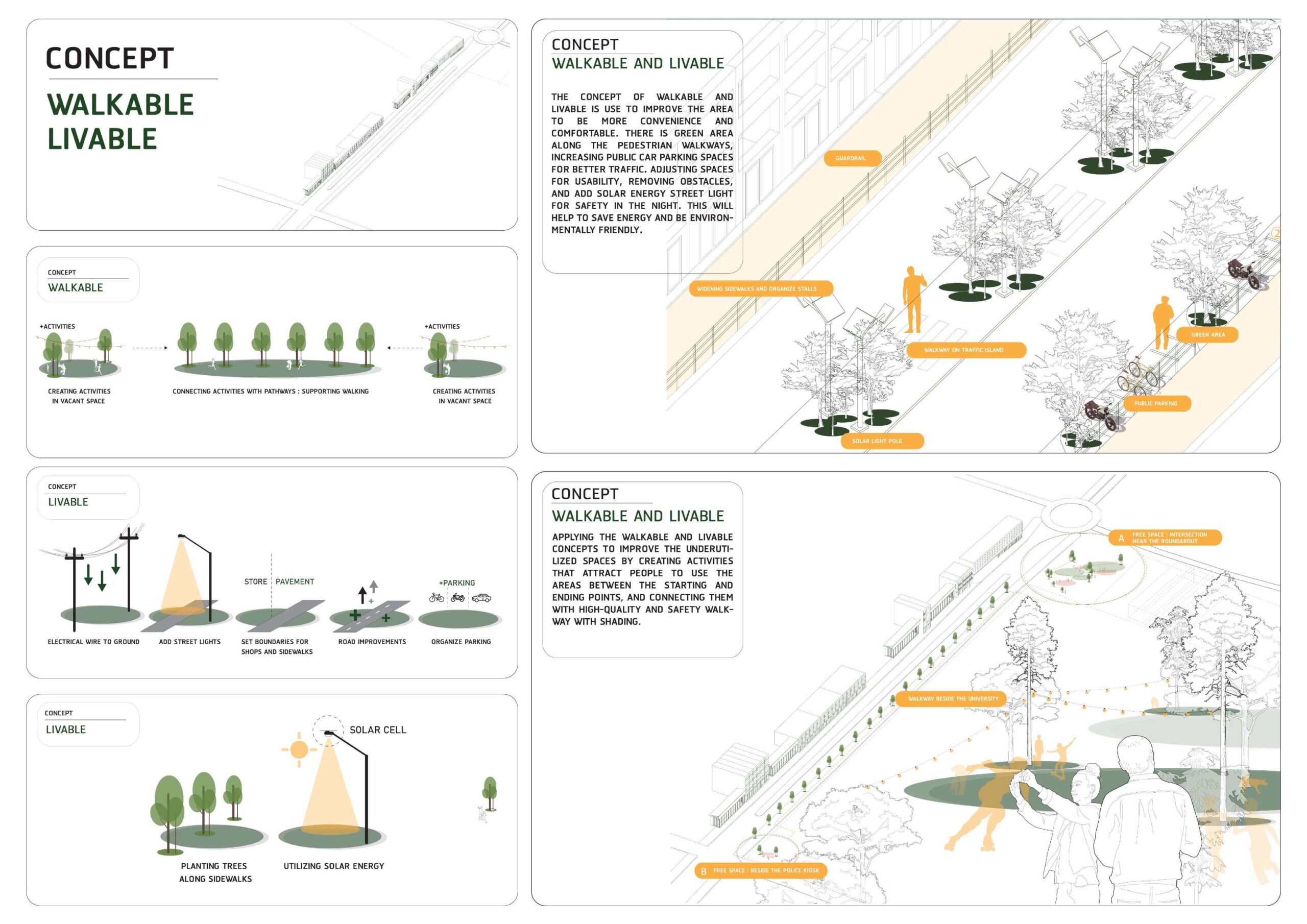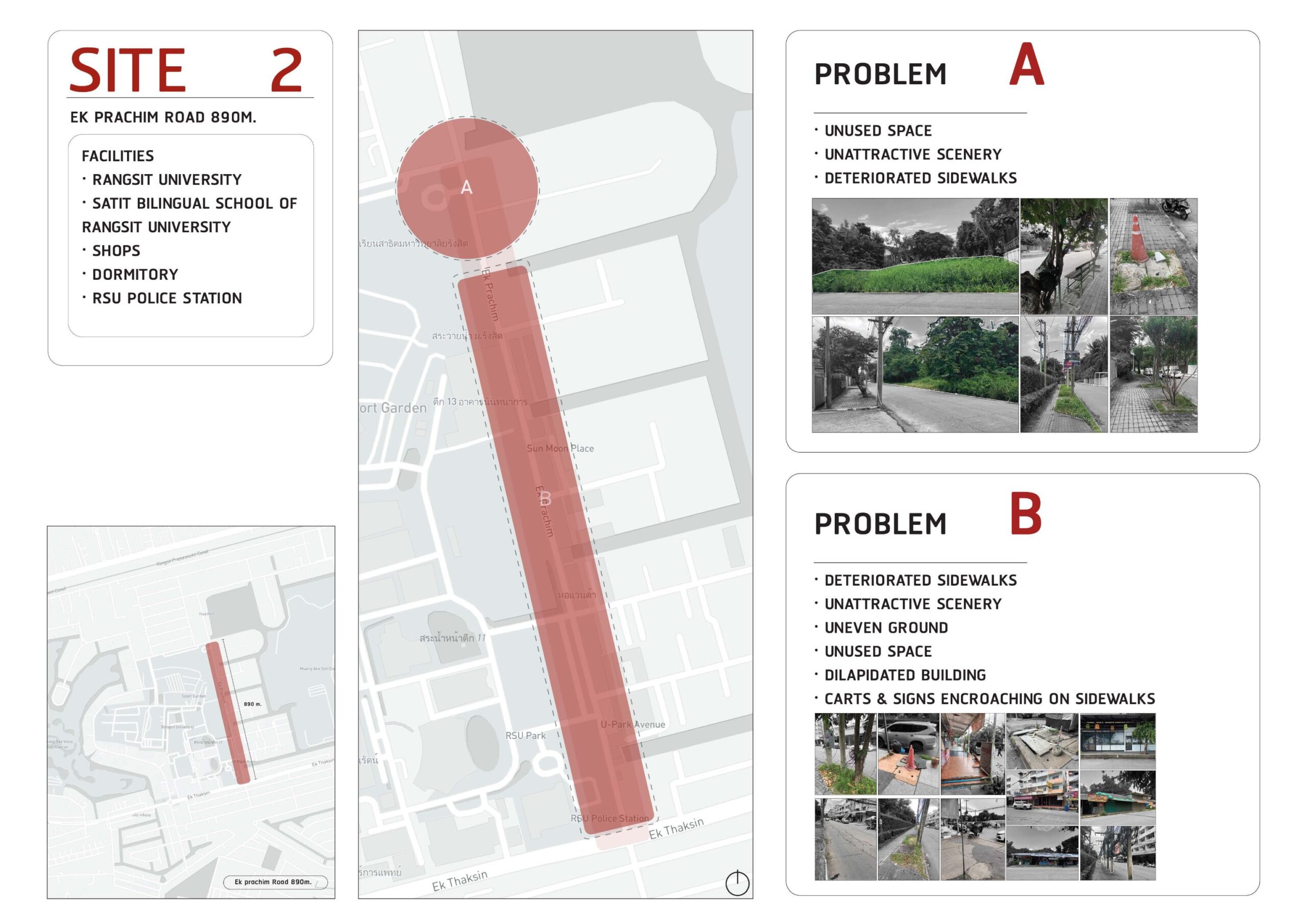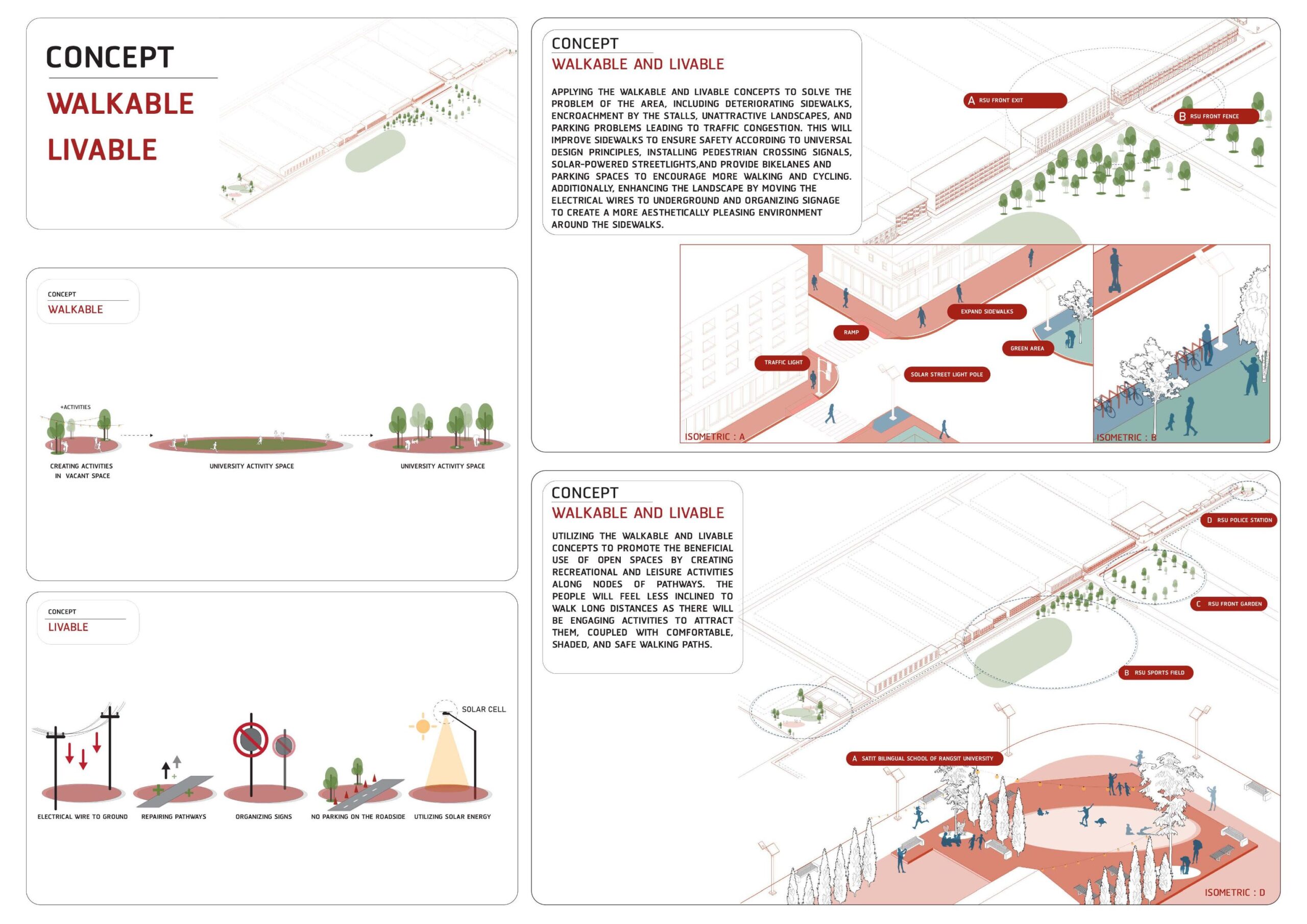
Asst. Prof. Kritaporn Lappimol, Ms. Kewalin Wongsangiam, Mr. Prompiriya Rangsawai and Mr.Asst. Prof. Kritaporn Lappimol, Ms. Kewalin Wongsangiam, Mr. Prompiriya Rangsawai and Mr. Theerapat Seeprasert




Abstract :
Muang Ake is a prime residential village with various facilities. An important and central facility of the area is Rangsit University, a large educational institution that attracts various activities, people, shops, and various types of residences and increases the density of the area around it. At present, the environment around the university faces many problems, especially physical problems, such as scenery and inefficient use of spaces. Therefore, the development of the Muang Ake area with the concepts of Walkable & Livable City were proposed. The concepts focus on designing livable areas and environments to promote a good quality of life and co-living.
The important objectives of studying and designing for Muang Ake area development with the concepts of Walkable & Livable City are: (1) to study and understand the contexts and elements of the city in various aspects; (2) to analyze the problems and potential of the area using the principles of urban planning and urban design; and (3) to design and improve the physical elements and environment of Muang Ake area with the concept of Walkable & Livable City.
This design and study aimed to use the principles of urban planning and urban design to solve problems and improve the physical conditions of Muang Ake to be more usable, more comfortable, safer, and have a more pleasant environment. The proposed development ideas used from the Walkable & Livable City concepts as the main guidelines, including adding facilities to promote walking and cycling, increasing green spaces, improving the scenery, improving a people-friendly environment, energy saving, and creating recreational activities to connect each area together. Therefore, this development guideline creates good spaces and environment for good quality of life and living together sustainably.
Objectives :
(1) To study and understand various contexts and elements of the community
(2) To analyze problems and potential of the area with the principles of urban planning and urban design
(3) To design and improve the physical elements and environment of Muang Ake area with the concept of Walkable & Livable City
Conceptual Framework :
The development of Muang Ake area with the concepts of Walkable & Livable City can be summarized as a conceptual framework for study and design as follows:
The concepts of Walkable & Livable City were adopted as the main concepts of Muang Ake development. Both concepts focus on designing livable spaces and environments. The development concept framework was as follows:
The Walkable City concept focuses on designing physical elements to promote walking (walk-ability) and bicycle use (ride-ability). The walkable city creation from the book Walkable City by Jeff Speck consists of 10 principles as follows: (1) reducing the number of cars on the roads so that the roads can be changed into public spaces and allow people to walk safely; (2) supporting mixed land use; (3) limiting parking areas to prevent too many parking spaces from interfering with activity connections and organizing sidewalk areas to truly facilitate walking; (4) supporting mass transit system; (5) protecting pedestrian areas by limiting space for cars or limiting the speed of the cars for safety; (6) promoting cycling by providing cycling routes that are safe and compatible with the roads; (7) designing pleasant sidewalks with a right width, a smooth and non-slip surface, no obstructions, and a continuation of walking to support good walking; (8) planting trees to provide shade for walking people, reducing heat from the road surface and air pollution; (9) creating an atmosphere that is conducive to walking by promoting appropriate activities on both sides of the roads; and (10) selecting target areas where walking can promote economic and social conditions as well as interactions between people for physical modifications.
The Livable City concept focuses on creating a city of happiness and convenience for residents created by the American Institute of Architects. The 10 principles of the Livable City consist of: (1) designing on a human scale: locate shops, workplaces, and public services within walking distance from residences; (2) providing choices: create pleasant options and environment that are suitable for living; (3) encouraging mixed-use development: promote mixed use of space to create vibrant areas; (4) preserving urban centers: preserve valuable original areas or buildings in the area; (5) varying transportation options: promote walking, cycling, and public transportation use; (6) building vibrant public spaces: create usable public spaces for relaxation and interaction; (7) creating a neighborhood identity: create a sense of place or an identity of the area; (8) protecting environmental resources: preserve the environment and natural resources; (9) preserving landscapes: preserve the cultural landscape of the area; and (10) design matters: appropriate design is an important basis of a livable community.
Process / Methodology :
In studying and developing Muang Ake area with the concept of Walkable & Livable City, the study and design process was as follows:
- Studying and surveying design data, which can be divided as follows:
- Studying and surveying primary data, such as field surveying, to understand the current physical, economic, social conditions, and various problems in the area
- Studying and surveying secondary information, including studying and researching information from various documents, for analyzing together with the primary data obtained from surveying the area
(2) Analyzing design data
In the design data analysis, the collected primary data and secondary data were analyzed using SWOT Analysis to know the strengths, weaknesses, opportunities, and limitations of the area in various dimensions as well as summarize the problems and potential for the area development.
(3) Design data synthesis
From the analysis of the problems and potential, trends and visions of development appropriate for the Mueang Ake area were a good educational and residential area that is worth living and visiting. Therefore, the development concept that is in accordance with this development vision is Walkable & Livable City.
(4) Designing
In the design process, a site area was selected to present a physical design idea to reflect the concrete development of the concept, leading to the creative development at the city, area, community, and environmental levels to be livable and worth visiting.
Techniques and Materials :
–
Result / Conclusion :
Muang Ake is a village of homes as well as large and small educational institutions. Therefore, there are many crowded and unregulated people and activities, especially the area around Rangsit University which is the center of the area. There are Ek Thaksin Road and Ek Prachim Road, the easily accessible main roads which are used by many people and activities. This causes physical and environmental problems, including unused spaces, lack of maintenance of road islands, visual problems from electrical wires and store signs, dilapidated sidewalks, uneven floors, shops and trees obscuring sidewalks, traffic jams, roadside parking, etc.
Therefore, the concepts of Walkable & Livable City had been adopted as a development guideline for the area, including bringing electrical wires into the ground, defining the area of the stores, separating trees and sidewalks, improving roads, organizing each type of parking space, planting trees along the sidewalks, adding rainwater collection points for tree caring, creating activities in free spaces and activities along the sidewalks to encourage walking, organizing billboards, adding street lights for safety at night, and saving energy by using solar cells. All of these development guidelines are the results of the design study which is a part of improving the scenery around Rangsit University which is the center (node) of people and activities to be more efficient and usable. In addition to improving the physical spaces in relation to the environmental contexts, it also stimulates the economy of shops and communities. That is, when the sidewalks and environment are pleasant to walk on, more people will be attracted to come out for shopping and having recreational and leisure activities together as well as good social interaction. Therefore, it is obvious that the development of the Muang Ake area, in addition to having a direct physical impact on the environment, is also important to the economic and social systems of the community as well.
References :
AIA Center for Communities by Design. (2018). The AIA’s 10 Principles for Livable Communities.www.aia.org/livable.https://modestoartmuseum.files.wordpress.com/2017/04/liv_10principles_flyer-1.pdf
Charles Montgomery. (2014). Happy City: Transforming Our Lives through Urban Design. Farrar, Straus and Giroux (US)
Jeff Speck. (2022). Walkable City: How Downtown Can Save America, One Step at a Time. St Martin’Press(US).
Kornkamon Sriwat. (14 October 2020). Why do walkable cities make the economy good. www.theurbanis.com. https://theurbanis.com/economy/14/10/2020/3752
Sitthiporn Piromruen.(2006-2007). Sustainable and Livable Urban Design: Theory and Practice. JOURNAL OF THE FACULTY OF ARCHITECTURE SILPAKORN UNIVERSITY, 22, 111-142.